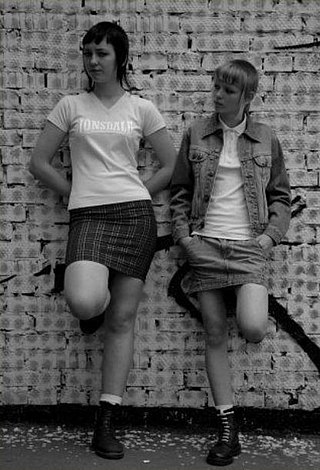
A skinhead or skin is a member of a subculture that originated among working-class youths in London, England, in the 1960s. It soon spread to other parts of the United Kingdom, with a second working-class skinhead movement emerging worldwide in the late 1970s. Motivated by social alienation and working-class solidarity, skinheads are defined by their close-cropped or shaven heads and working-class clothing such as Dr. Martens and steel toe work boots, braces, high rise and varying length straight-leg jeans, and button-down collar shirts, usually slim fitting in check or plain. The movement reached a peak at the end of the 1960s, experienced a revival in the 1980s, and, since then, has endured in multiple contexts worldwide.
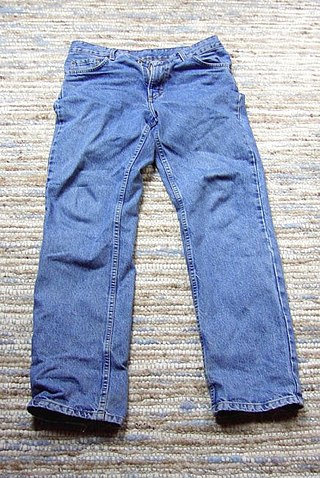
Jeans are a type of trousers made from denim or dungaree cloth. Often the term "jeans" refers to a particular style of trousers, called "blue jeans", with the addition of copper pocket rivets added by Jacob W. Davis in 1871 and patented by Davis and Levi Strauss on May 20, 1873. Prior to the patent, the term "blue jeans" had been long in use for various garments, constructed from blue-colored denim.
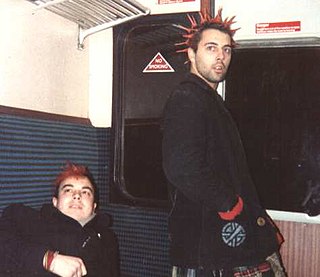
Punk fashion is the clothing, hairstyles, cosmetics, jewellery, and body modifications of the punk counterculture. Punk fashion varies widely, ranging from Vivienne Westwood designs to styles modeled on bands like The Exploited to the dressed-down look of North American hardcore. The distinct social dress of other subcultures and art movements, including glam rock, skinheads, greasers, and mods have influenced punk fashion. Punk fashion has likewise influenced the styles of these groups, as well as those of popular culture. Many punks use clothing as a way of making a statement.

Shorts are a garment worn over the pelvic area, circling the waist and splitting to cover the upper part of the legs, sometimes extending down to the knees but not covering the entire length of the leg. They are called "shorts" because they are a shortened version of trousers, which cover the entire leg, but not the foot. Shorts are typically worn in warm weather or in an environment where comfort and airflow are more important than the protection of the legs.
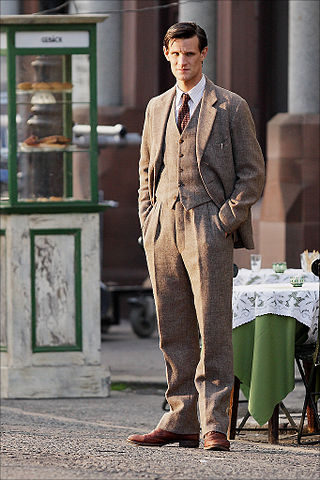
A suit, lounge suit, or business suit is a set of clothes comprising a suit jacket and trousers of identical textiles generally worn with a collared dress shirt, necktie, and dress shoes. A skirt suit is similar, but with a matching skirt instead of trousers. It is currently considered semi-formal wear or business wear in contemporary Western dress codes, however when the suit was originally developed it was considered an informal or more casual option compared to the prevailing clothing standards of aristocrats and businessmen. The lounge suit originated in 19th-century Britain as sportswear and British country clothing, which is why it was seen as more casual than citywear at that time, with the roots of the suit coming from early modern Western Europe formal court or military clothes. After replacing the black frock coat in the early 20th century as regular daywear, a sober one-coloured suit became known as a lounge suit.
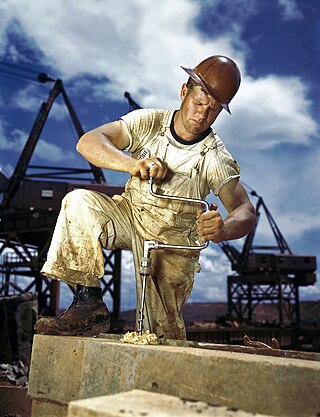
Overalls or bib-and-brace overalls, also called dungarees in British English, are a type of garment usually used as protective clothing when working. The garments are commonly referred to as a "pair of overalls" by analogy with "pair of trousers".

Suspenders, or braces are fabric or leather straps worn over the shoulders to hold up skirts or trousers. The straps may be elasticated, either entirely or only at attachment ends, and most straps are of woven cloth forming an X or Y shape at the back. Suspenders are typically attached to skirts and trousers with clips or buttons using leather tabs at the ends.

Bell-bottoms are a style of trousers that become wider from the knees downward, forming a bell-like shape of the trouser leg.

Parachute pants, originally known as flight pants, are a style of trousers characterized by the use of nylon, especially ripstop nylon.
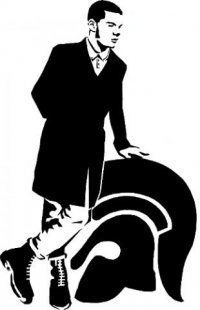
The suedehead subculture was an early-1970s offshoot of skinhead subculture in the United Kingdom and Ireland. Although sharing similarities to 1960s skinheads, suedeheads grew their hair longer and dressed more formally. Although often working class like skinheads, some had white collar jobs. A female suedehead was a sort.

Mary Jane is an American term for a closed, low-cut shoe with one or more straps across the instep.

Fashion of the 1980s was characterized by a rejection of 1970s fashion. Punk fashion began as a reaction against both the hippie movement of the past decades and the materialist values of the current decade. The first half of the decade was relatively tame in comparison to the second half, which was when apparel became very bright and vivid in appearance.

Fashion of the 1960s featured a number of diverse trends, as part of a decade that broke many fashion traditions, adopted new cultures, and launched a new age of social movements. Around the middle of the decade, fashions arising from small pockets of young people in a few urban centers received large amounts of media publicity, and began to heavily influence both the haute couture of elite designers and the mass-market manufacturers. Examples include the mini skirt, culottes, go-go boots, and more experimental fashions, less often seen on the street, such as curved PVC dresses and other PVC clothes.

Knee highs are hosiery that cover the feet and legs up to the knee. A fashion accessory for casual and classic cool or warm weather apparel. Typically worn by women in many societies, they are sometimes worn with modern semi-formal attire. Unlike ordinary socks, they are generally made of nylon or other stocking materials. There were also different types and uses of knee highs for women.

Slim-fit pants or skinny jeans are tight trousers that have a snug fit through the legs and end in a small leg opening that can be anywhere from 9" to 20" in circumference, depending on size. Other names for this style include drainpipes, stovepipes, tight pants, cigarette pants, pencil pants, skinny pants, gas pipes, skinnies, and tight jeans.
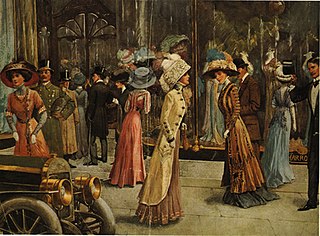
Fashion in the period 1900–1909 in the Western world continued the severe, long and elegant lines of the late 1890s. Tall, stiff collars characterize the period, as do women's broad hats and full "Gibson Girl" hairstyles. A new, columnar silhouette introduced by the couturiers of Paris late in the decade signaled the approaching abandonment of the corset as an indispensable garment.

Trousers, slacks, or pants are an item of clothing worn from the waist to anywhere between the knees and the ankles, covering both legs separately. In the United Kingdom, the word pants generally means underwear and not trousers. Shorts are similar to trousers, but with legs that come down only to around the area of the knee, higher or lower depending on the style of the garment. To distinguish them from shorts, trousers may be called "long trousers" in certain contexts such as school uniform, where tailored shorts may be called "short trousers" in the UK.

Underwear, underclothing, or undergarments are items of clothing worn beneath outer clothes, usually in direct contact with the skin, although they may comprise more than a single layer. They serve to keep outer clothing from being soiled or damaged by bodily excretions, to lessen the friction of outerwear against the skin, to shape the body, and to provide concealment or support for parts of it. In cold weather, long underwear is sometimes worn to provide additional warmth. Special types of undergarments have religious significance. Some items of clothing are designed as undergarments, while others, such as T-shirts and certain types of shorts, are appropriate both as underwear and outerwear. If made of suitable material or textile, some underwear can serve as nightwear or swimwear, and some undergarments are intended for sexual attraction or visual appeal.
A man's suit of clothes, in the sense of a lounge or business or office suit, is a set of garments which are crafted from the same cloth. This article discusses the history of the lounge suit, often called a business suit when featuring dark colors and a conservative cut.

Merc Clothing is a United Kingdom-based clothing company which specialises in the production of shirts, trousers, suits, parkas, harrington jackets, shoes and accessories for men and women.


















